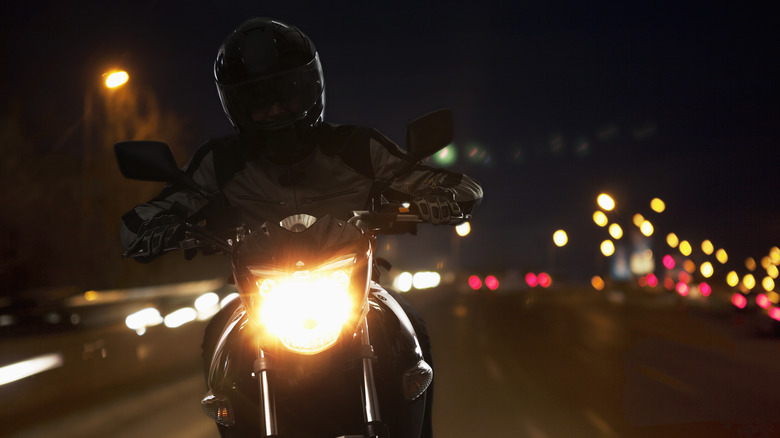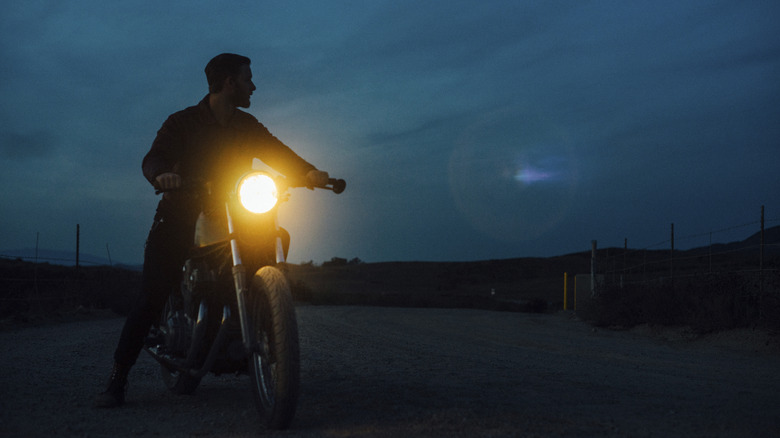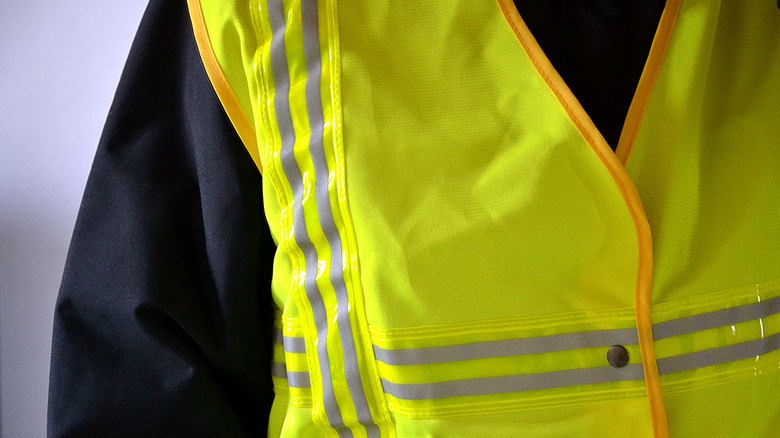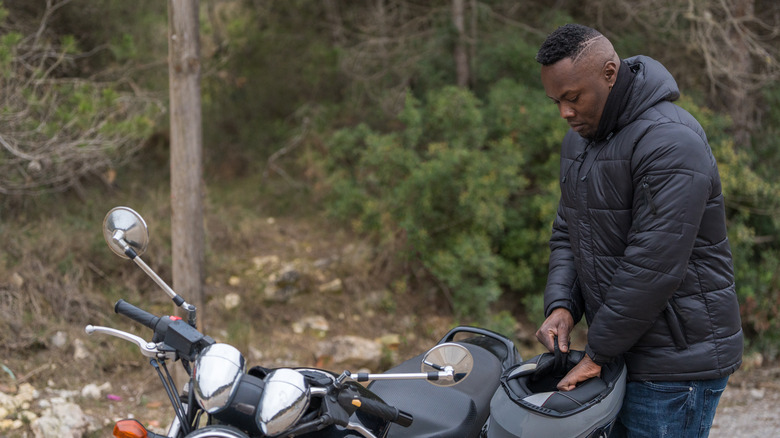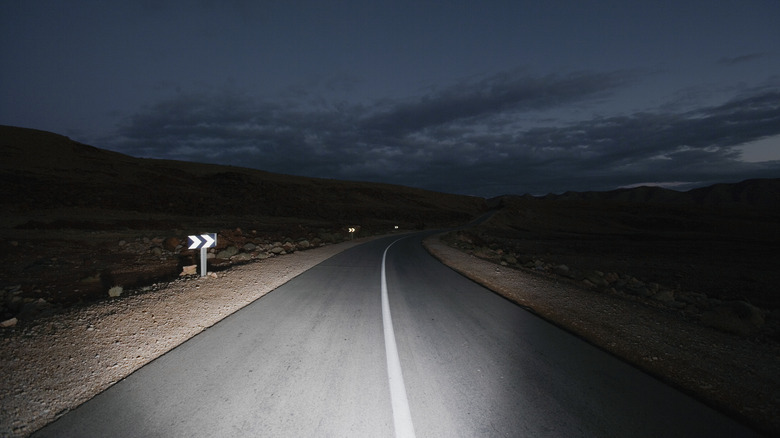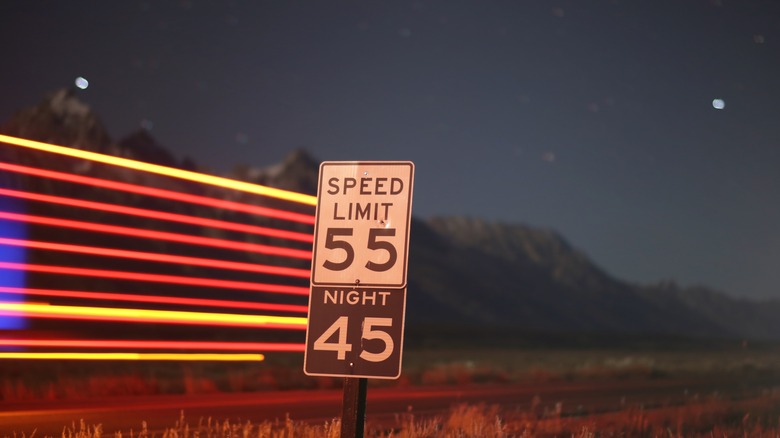5 Tips To Keep You Safe When Riding Your Motorcycle At Night
There's a very distinctive sense of adventurous romance that comes with riding a motorcycle at night. Compared to driving a car when it's dark out, riding a motorcycle makes you feel more at one with the night sky, stars twinkling overhead as your taillights cut a swath through the inky shade. No matter how romantic it is, though, you shouldn't let yourself get so swept up in the atmosphere that you forget to keep yourself safe.
Riding a motorcycle is an intense enough task when you're doing it in broad daylight, so completely eliminating illumination from the equation only makes things more complicated. As fun as it is to take a nighttime spin down a back road or across the highway, you have a responsibility to yourself and other motorists to undertake every possible safety precaution, lest the morning sun find you in a ditch somewhere. Thankfully, most of the precautions you need to take are very sensible, requiring only a little more thought than the precautions you hopefully already take when riding your motorcycle.
Find the way with your headlights and the lights of other motorists
When driving any kind of motor vehicle, motorcycles especially, one of the cardinal rules is to turn on those headlights when it starts getting dark out. If the sun is starting to go down and you tell yourself, "it's fine, I can still basically see the road," guess what: it's not fine. "Basically" seeing the road is not the same thing as seeing the road, as well as any obstacles and obstructions that happen to be present on it. If your visibility is even slightly reduced, turn on those headlights. Additionally, if it's pitch-black out and there are no other motorists around, use your brights to provide even more illumination. Just remember to turn them off if there are other drivers around so you don't accidentally blind someone.
Speaking of other motorists, your own lights aren't the only thing to be mindful of at night. Keep an eye out for the headlights and taillights of other motorcycles and cars on the road. When it's dark out, you may not be able to immediately discern how large or close another vehicle is at a glance, but their lights can give you a better idea of your positioning relative to theirs. You may also be able to spot obstacles and obstructions in the headlights of others, which can give you more time to stop and maneuver if necessary.
Use accessories to make yourself more visible
Taillights and headlights help to make your motorcycle more visible at night for other drivers, but they don't make you more visible. Another driver may not be able to see you in time if your motorcycle's lights aren't that bright or you're driving on an angled road. This is why motorcycle accidents are more common at night, because other drivers can't properly see you coming. To lower the odds of that happening, you need to make yourself as visible as realistically possible.
The best way to increase your personal visibility is through the use of high-visibility clothing and accessories. Fluorescent, reflective helmets, jackets, vests, and more will bounce back the light of another vehicle's headlights, making you much more visible from further away. You can attain a similar effect by attaching reflective tape or decals to any existing articles of clothing you're wearing like a riding jacket or a backpack, as well as to your motorcycle itself. There are even special kits available that you can use to add taillights and turn signals to your own motorcycle helmet, just for that added bit of flash and visibility.
Dress properly to accommodate for the elements
One of the trade-offs to riding a motorcycle, compared to driving a car, is that you're always exposed to the elements. Aside from some small measures like heated handlebar grips, there's not much your bike can do for you to keep you warm and dry, so it's on you to dress appropriately. This is even more important at night when, depending on where you live and the time of year, the temperature can drop severely. If you tried to drive around in a t-shirt while it's chilly, you're asking to have your arms go numb from the wind chill. If you're going to be driving at night, make sure you have a warm jacket or coat to keep the wind away, as well as a pair of gloves and goggles for similar purposes.
Additionally, while it can happen during the day, a cold night is prime time for fog. If you thought your visibility was bad enough on a warm night, try a cold night with your helmet visor and windscreen fogging up. If the fog is rolling in, make sure to wear a fog-proof visor or goggles. If you don't have fog-proof items, you can use special chemical treatments to keep them from fogging up. Make sure you're using a solution that's safe for visor, goggle, and glasses lenses.
Keep yourself alert and awake
The call to sleep is just as tempting as the call of the night, if not more so, which is a bit of a problem for nighttime riders, because they are definitely not compatible. Drowsiness is the mortal enemy of any late-night motorists, doubly so when a slight sleepy slouch could mean physically falling off of your motorcycle. If you can help it, try not to go out on your motorcycle at night if you haven't had a good amount of sleep in preparation. If you're too tired to get your keys in the ignition on the first try, it's not a good night for a ride. Go back inside and go back to bed.
Even if you're fairly well-rested, the aforementioned call of the night can tug on your natural instincts to sleep. There's an actual phenomenon called "highway hypnosis" where a monotonous drive can gradually wear down your conscious focus. Keep your attention on the road and don't drift off into habit, and if absolutely necessary, have a bit of coffee or an energy drink. It's no substitute for proper sleep, but it can get you home in a pinch. On the subject of mind-affecting substances, though, a quick reminder: absolutely do not consume any alcoholic beverages before driving at night. Obviously, you shouldn't be drinking and driving at all, but you especially shouldn't do it at night when you need full command of your faculties to stay safe.
Maintain a reasonable speed, even if the road looks empty
When you're all alone on the highway at night, with nobody around to keep you in check, it can be tempting to throw caution to the wind and rev your motorcycle up to its full capacity to tear things up. As fun as that sounds, though, going whole-hog at night is not a good idea.
The thing about night driving is that even if you're currently alone with no obvious obstructions in front of you, that can change at a moment's notice. Obstacles you couldn't see previously can appear in your headlights very quickly, ranging from a sporadic pothole to an unfortunate road-traversing critter. If you're screaming down the road at top speed, any reaction time you may have to avoid an obstacle is severely reduced, if not lost entirely, which can spell trouble. Ignore the temptation to go whole-hog and keep your speed reasonable and in accordance with set speed limits. That way, if something does suddenly appear in your headlights, you'll have enough clearance to get around it.
